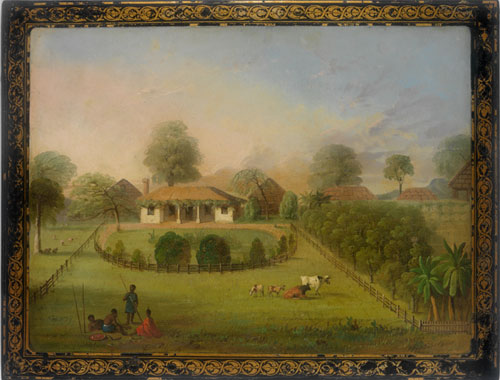Homesteading
'There is no rural picture more alluring that a pastoral holding in country fitted for agriculture where droughts come but rarely, flocks multiply in profusion, money flows freely, temperatures observe considerate averages and life is close to the idyllic...'
‘On the Land, Farm and Station’, Sydney Morning Herald, 8/9/1906, p.7.
Homesteading in rural Australia provided a profitable and idyllic lifestyle for some, though life could just as quickly turn to misery during hard times.
Domestic life in the bush passed slowly. Gardening, music and books offered welcome diversions, while social interaction with neighbours, friends and visitors brought news and lively discussion to break the monotony, supplemented by an occassional trip to Sydney or one of the large inland towns. There were also times of ardous labour - sowing, harvesting, mustering, lambing, branding and shearing - as well as terrifying periods of drought, disease, bush fire and flood.
The isolation of many rural properties was such that dry supplies of flour, sugar, rice, tea and were brought in only once a year which meant that most homesteads needed to be as self-sufficient as possible. Eggs, vegetables, milk, bacon, meat and fruit were produced on the property which saw the face of Australia's rapidly spreading agricultural districts gradually softened by the growth of the ornamental and kitchen gardens, orchards and plantations that surrounded the typical colonial bush homestead.
 Original Yulgilbar Homestead, property of E.D.S. Ogilvie, ca.1852, by Ellen Bundock.
Original Yulgilbar Homestead, property of E.D.S. Ogilvie, ca.1852, by Ellen Bundock. Oil on panel. PXA 2693
On larger properties, the homestead was occupied by the owner or manager, with his wife and family and attendant servants, surrounded by stables, out buildings and various accommodations for agricultural workers and stockmen with yards on either side for mustering horses, sheep and cattle. Most homesteads were alike in appearance and many had grown from an original single cell cottage. These long, low bungalows were usually built from slabs of hand-cut, local timber with a neat pitched roof, wide chimney piece to one side and deep cool verandahs set in the sheltered hollow of a hill amid carefully cultivated gardens against dramatic mountains of the broader landscape facing the river or fat pasturage below. The bush was kept at bay with post and rail fences criss-crossing over the spreading plains beyond the homestead gate approached by a sandy track winding up from the road or river bank.
By the early 1800s, a flourishing local market had emerged for views of private town houses and country seats as a record of colonial success and to provide a visual reminder of the pleasures of rural life. The spread of settlement during the 1830s saw house portraits produced in even greater numbers by professional and amateur artists alike, becoming increasingly popular as the number of professional artists working in the colonies grew after the 1850s.
> Find out more about the creation of the Australian homestead idyll through art
House portraits serve as an important visual record of the aspirations of successful colonial land owners. Some artists depicted homesteads in stark isolation choosing to concentrate on the sheer effort required to tame, order, fence and manicure the bush into parkland. While others showed not only the house in the landscape but also prize-winning livestock, proud pioneers riding fine horses and well-dressed family members undisturbed by the daily rigours of manual farm labour.
Such representations of colonial Australian life played a part in attracting immigrants from the northern hemisphere, enticing them with notions of the gracious living and affluence to be had in the colonies. The popularity of house portraits began to decline in the late 19th century as photography became the preferred medium for landowners wishing to possess a permanent record of their properties.


